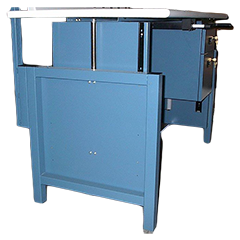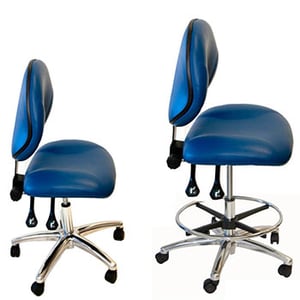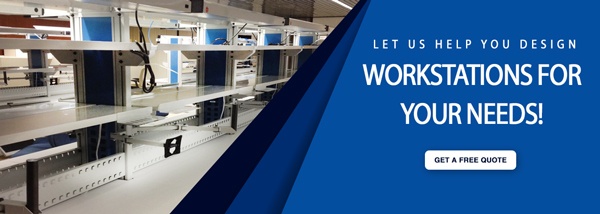Sitting at an assembly workstation for an entire shift can feel unnatural to the body. However, for many workers in the manufacturing industry, sitting or standing in one place is often part of the job.
That’s especially true for employees whose jobs involve using an assembly workstation for production. To stay healthy and maintain productivity in the workplace, it is important to customize workspaces to fit the workers using them.
To create an environment where workers are healthier and happier, more companies are incorporating the concept of ergonomics into their workplace design. Ergonomics isn’t a fad, nor is it a bottomless money pit.
In fact, research shows companies that embrace ergonomics, in order to reduce discomfort and injuries, actually save more money over time. OSHA reports that for every $3 spent on workers’ compensation claims, $1 of that results from a lack of ergonomic protection.
Neck and lower back pain … two areas of the body most commonly associated with a lack of ergonomics … cost $88 billion in health spending, according to the Journal of American Medical Association.
Most ergonomic concepts center around maintaining a relaxed position that minimizes stress on a person’s joints and muscles. Having the right workstation that promotes this type of support is key.
Here are some of the ways a workbench incorporates ergonomic design to improve worker health.
Adjustable Workstations
 Ergonomically adjustable hydraulic benches allow workers to choose whether they want to sit down or stand up. Employees simply use the manual hand crank or electric control to lift and lower the bench to a comfortable height. Some controls also allow you to preset positions for convenience.
Ergonomically adjustable hydraulic benches allow workers to choose whether they want to sit down or stand up. Employees simply use the manual hand crank or electric control to lift and lower the bench to a comfortable height. Some controls also allow you to preset positions for convenience.
The most common design hydraulically lifts the entire work surface and attachments. This reduces the potential for injuries to workers’ backs from lifting the work surface themselves.
If a workstation does not have a hydraulic feature, it can still be ergonomically-friendly if the workstation is adjustable by allowing workers to manually adjust the station in order to choose the height that best fits their bodies. An optimal neutral posture where the body is at its strongest and most efficient position will help minimize the risk for injuries.
Drawers
Drawers are a staple in most workbenches. However, ergonomically-designed drawers help optimize the workspace because they prevent repeated strains to the body.
This design offers a higher level of accessibility, allowing workers to have contact with the drawers without having to unnaturally reach for them.
This is important because tears and strains are some of the most common examples of musculoskeletal injuries among manufacturing workers. These types of soft-tissue injuries are caused when workers overexert … at times during the most routine of tasks like reaching for a drawer.
Other Workstation Components
There is a wide range of add-on workstation accessories that can help promote a more ergonomically-friendly workspace. These accessories can assist with preventing employees from completing tasks outside their neutral reach zones.
Examples of accessories that can be incorporated into the design of an assembly workstation include:
- Monitor holders, which permit the easy movement of computer monitors to keep them at correct eye level for different employees in shared workspaces
- Keyboard trays, which ensure employees’ shoulders and wrists are in the correct position when typing or using a mouse
- Shelving and bins, which allow employees to have tools and parts close at hand
- Document holders, which keep necessary files, folders, instructions and other items within easy reach
Chairs
 The chair is an important component of any workstation and should have ergonomic characteristics as well. Ergonomically-supportive chairs should include:
The chair is an important component of any workstation and should have ergonomic characteristics as well. Ergonomically-supportive chairs should include:
- Sturdy frames
- Adjustable height capabilities
- Comfortable backrests and seats
When purchasing industrial furniture chairs, keep in mind cheap prices often lead to low quality and higher costs in the long run. Especially at laboratory workstations or for industrial applications, workers may sit for long periods of time. It is critical to find a chair that supports your employees’ posture and comfort … therefore, supporting their productivity and safety.
Proactive Approach
Ergonomics provide manufacturing facilities and other types of businesses with the opportunity to be proactive rather than reactive when it comes to worker safety.
Recent statistics show musculoskeletal injuries accounted for nearly 34% of days away from work in the manufacturing industry in 2017. Workplace injuries that cause employees to miss an extensive number of days can have a financial domino effect on several areas of a business. A company may be responsible for medical bills, employee time lost and possibly legal fees.
An industrial furniture manufacturer that emphasizes ergonomics and customization based on workers’ needs will help you put the safety and well-being of workers first.


